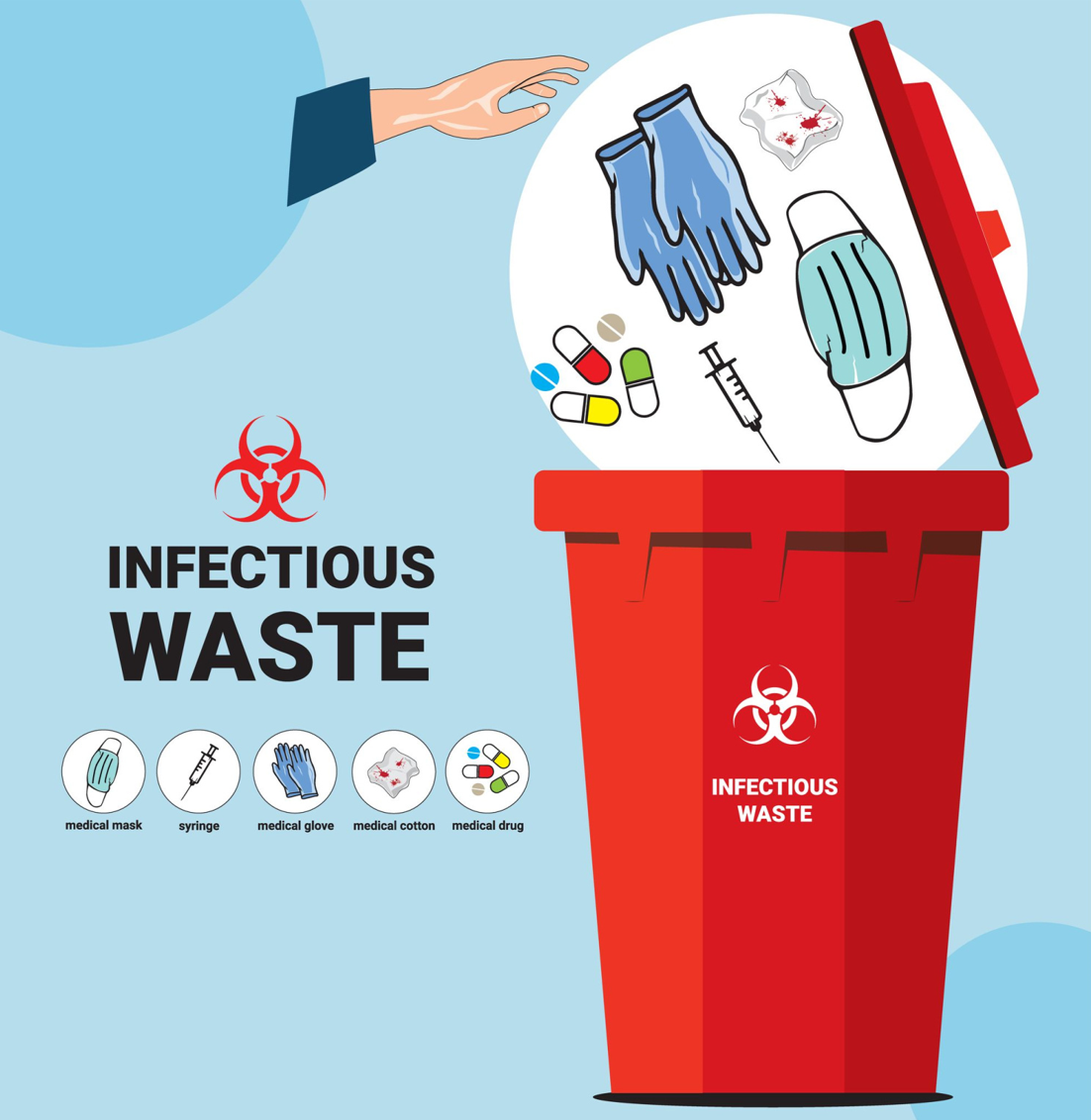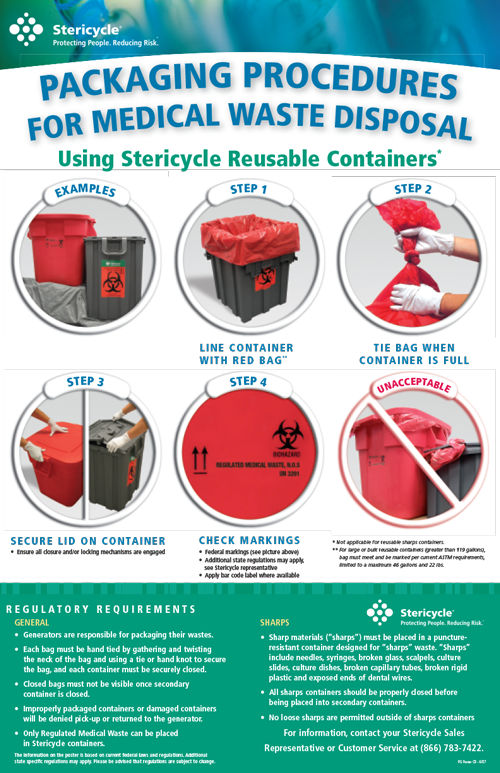Specialist Medical Waste Disposal Service: Guarding Your Facility and Community
Wiki Article
Compliance and Laws for Medical Garbage Disposal
Compliance and policies for clinical waste disposal play a vital role in making certain the security and wellness of both healthcare experts and the basic public. Appropriate management of clinical waste is essential to stop the spread of infections, shield the atmosphere, and maintain public health. These policies include different facets, consisting of the classification and partition of clinical waste, proper storage and managing procedures, as well as transport and disposal methods.Relevance of Compliance
The value of compliance with laws for clinical garbage disposal can not be overstated. Proper disposal of medical waste is critical for making sure the security and wellness of medical care workers, patients, and the general public. Clinical waste, that includes products such as utilized needles, polluted gloves, and biomedical waste, can pose major health dangers if not taken care of and gotten rid of effectively.Compliance with laws guarantees that medical waste is handled in such a way that minimizes the possibility for direct exposure to contagious diseases and harmful compounds - medical waste removal. It helps protect against the spread of infections, such as HIV, liver disease B and C, and other bloodborne virus. Conformity also plays a vital duty in safeguarding the environment by preventing contamination of water sources, dirt, and air
Failure to abide by regulations can lead to severe repercussions for medical care facilities, including fines, lawsuit, and damage to their track record. Additionally, non-compliance might compromise the wellness and security of healthcare workers, people, and the community.
Conformity with regulations for medical garbage disposal requires adherence to details guidelines and protocols. These might include correct segregation, product packaging, labeling, and storage of medical waste. It likewise involves using authorized disposal approaches, such as autoclaving, landfilling, or incineration, depending upon the kind of waste.
Governing Agencies and Bodies
Regulative firms and bodies play an essential role in overseeing conformity with guidelines for medical garbage disposal. These companies are accountable for establishing standards, criteria, and methods to guarantee the appropriate and risk-free handling of clinical waste. They check and implement conformity to protect public health and the atmosphere.Among one of the most prominent regulatory agencies in the United States is the Environmental Defense Agency (EPA) The EPA is in charge of regulating the storage space, transportation, therapy, and disposal of clinical waste. They develop guidelines for waste generators, carriers, and therapy facilities to comply with, making certain that all necessary safety measures are taken to avoid the spread of diseases and contamination.
One more essential regulatory body is the Occupational Safety and Health Management (OSHA) OSHA establishes guidelines and requirements to safeguard workers from work-related risks, consisting of those pertaining to medical waste. WasteX Medical Waste Disposal. They supply guidelines for the risk-free handling and disposal of medical waste to secure workers in healthcare facilities
In enhancement to these federal agencies, specific states also have their very own governing bodies that manage clinical waste disposal. These firms may have their own certain laws and demands that have to be followed.

Classification and Partition of Clinical Waste
To make certain correct administration of clinical waste, it is essential to categorize and segregate it according to established procedures and standards. medical waste disposal service. Classification and partition play a critical role in decreasing the threat of infection, protecting the setting, and guaranteeing the safety and security of healthcare workers and the basic publicMedical waste is categorized into different groups based on its potential threat level. These categories include transmittable waste, pathological waste, sharps waste, pharmaceutical waste, chemical waste, and radioactive waste. Each category calls for specific handling, storage space, disposal, and transportation approaches to reduce the threat of exposure and contamination.
Partition of medical waste involves separating various kinds of waste at the source. This process makes sure that waste with different hazard degrees is not combined, decreasing the potential for cross-contamination and making disposal procedures extra efficient. Appropriate segregation is attained via the use of color-coded tags and containers, which help health care workers and waste monitoring personnel take care of each kind and determine of waste properly.
In addition to classification and segregation, healthcare centers must also stick to neighborhood, state, and government laws pertaining to clinical waste monitoring. These policies outline details requirements for storage space, transportation, treatment, and final disposal of medical waste, making sure conformity and maintaining public wellness and security.
Proper Storage and Dealing With Procedures
Proper storage space and taking care of treatments play a critical role in making sure the certified and risk-free administration of medical waste. Clinical waste, which consists of products such as used syringes, contaminated gloves, and expired drugs, can posture significant health and ecological risks if not taken care of properly. It is essential for health care facilities and other generators of medical waste to carry out strict storage and managing methods.
To start with, medical waste needs to be kept in durable, leak-proof containers that are especially made for this objective. These containers should be identified with the universal biohazard symbol and words "clinical waste" to clearly suggest the contents. Furthermore, the containers should be kept safely near avoid any possible leakage or spillage.
Additionally, it is important to set apart various types of clinical waste to avoid cross-contamination. Sharps, such as needles and scalpels, should be saved in puncture-resistant containers to lessen the danger of injuries - WasteX Medical Waste Disposal. Chemical waste, such as solvents and disinfectants, should be kept individually from other kinds of clinical waste to avoid chemical reactions or unsafe direct exposures

Transport and Disposal Approaches
Healthcare facilities have to guarantee the risk-free transportation and appropriate disposal of their clinical waste to comply with policies and shield public health. Transport and disposal techniques play a critical duty in preventing the spread of contagious conditions and minimizing the environmental effect of clinical waste.
To move medical waste, healthcare facilities should utilize puncture-resistant and leak-proof containers that are identified with the biohazard sign. These containers should be securely secured to stop any type of leakage during transport. In addition, healthcare centers need to establish methods for the transportation process, including using dedicated cars and qualified workers.
When the medical waste reaches the disposal facility, it undertakes numerous methods of therapy - WasteX Medical Waste Disposal. One typical method is incineration, which involves burning the waste at high temperature levels to destroy pathogens and lower the quantity of waste.
It is essential for healthcare centers to collaborate with licensed and allowed waste management business to ensure correct transport and disposal of medical waste. These firms have the Our site proficiency and sources to manage clinical waste safely and in conformity with regulations.
Verdict
In conclusion, compliance with policies for medical waste disposal is of utmost relevance to make certain public wellness and safety and security. On the whole, adherence to compliance and regulations is needed to effectively manage clinical waste.Clinical waste, which consists of products such as utilized needles, contaminated handwear covers, and biomedical waste, can position significant health threats if not dealt with and disposed of appropriately.
These categories consist of infectious waste, pathological waste, sharps waste, pharmaceutical waste, chemical waste, and contaminated waste.Partition of clinical waste entails separating different types of waste at the resource. Appropriate partition is attained through the use of color-coded containers and labels, which assist healthcare employees and waste administration workers identify and take care of each type of waste properly.
Chemical waste, such as solvents and disinfectants, must be stored separately from other types of medical waste to avoid unsafe exposures or chemical responses.
Report this wiki page